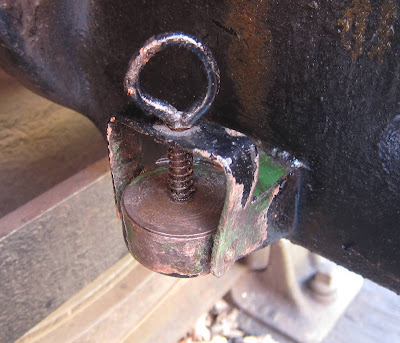I've visited the Cumbres and Toltec, Durango and Silverton, Georgetown Loop, Mount Rainier and a few others before. Cass was new to me and what a gem. It's steepest gradient is 11% or 1 in 9.09 and, according to wikipedia, is the third steepest non-rack railway in the world.
Cass is the home for Shay locomotives. Like Joyce (there is a connection), Shays are geared locomotives and they don't go fast. They are designed for steep gradients, sharp curves and poor track as built for logging railroads in the last century or earlier. Cass has about five operational Shays plus a Heisler and a Climax although not all in workable condition.
So what's a Shay?
 |
| Shay No. 2 at Bald Knob Summit |
 |
| Three cylinder vertical engine |
 |
| Three cylinder vertical engine with air brake pump in the foreground. Driveshafts are below. |
 |
| Drive shaft with gimbal bearing and square variable length shaft joint |
 |
| Other end of above drive shaft |
 |
| 2:1 Bevel gearing to axles |
 |
| RHS Action Packed side |
 |
| LHS not so populated |
 |
| Route from Cass to Bald Knob summit |
 |
| Loco Fleet |
 |
| Arriving at the 'Depot' |
The train propels the carriages (cars) from the depot up to the summit except in the zig-zag.
 |
| Departing from the depot. |
The train passes this location by the maintenance shed.
 |
| Running line leftmost |
 |
| Crossing approach |
Video clip is here on YouTube (including whistles galore but no bells).
 |
| Cass Level Crossing |
The line climbs up the hillside.
 |
| Line fades away behind |
 |
| Onwards and Upwards |
Video clip on YouTube of the train arriving at the zig (including no special sounds).
 |
| Line climbing to meet the zig-zag middle section |
The train approaches the down-coming train waiting on the top section of the zig-zag.
 |
| Down train ahead on left |
The up train goes into a long spur and waits while the down train follows into the spur. The down train then reverses out and down the zig; the up train then reverses out and up the zag.
The line climbs onwards to the summit at Bald Knob (4842 feet) through some amazing countryside.
 |
| Almost at the summit |
 |
| Shay No. 2 at the Bald Knob summit |
 |
| View backwards from whence we came |
A fantastic 5 hour journey, one of the best there is.







